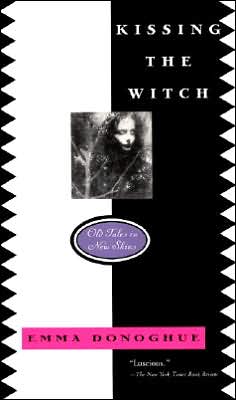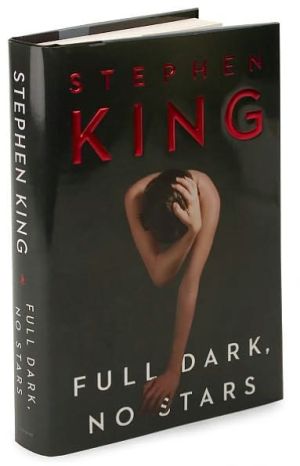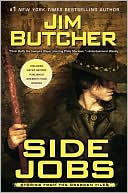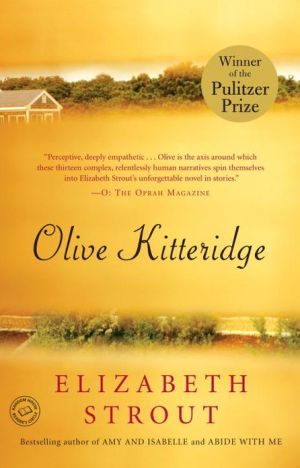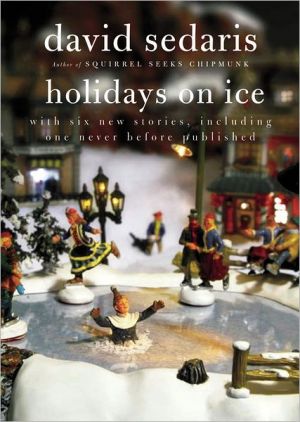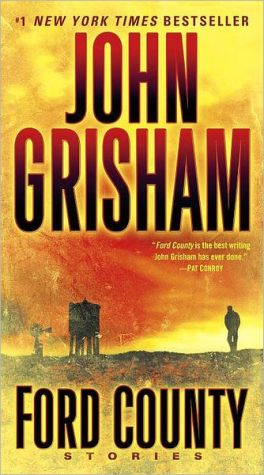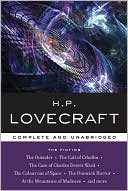Kissing the Witch: Old Tales in New Skins
Thirteen tales are unspun from the deeply familiar, and woven anew into a collection of fairy tales that wind back through time. Acclaimed Irish author Emma Donoghue reveals heroines young and old in unexpected alliances—sometimes treacherous, sometimes erotic, but always courageous. Told with luminous voices that shimmer with sensuality and truth, these age-old characters shed their antiquated cloaks to travel a seductive new landscape, radiantly transformed.Cinderella forsakes the handsome...
Search in google:
Thirteen tales are unspun from the deeply familiar, and woven anew into a collection of fairy tales that wind back through time. Acclaimed Irish author Emma Donoghue reveals heroines young and old in unexpected alliances—sometimes treacherous, sometimes erotic, but always courageous. Told with luminous voices that shimmer with sensuality and truth, these age-old characters shed their antiquated cloaks to travel a seductive new landscape, radiantly transformed.Cinderella forsakes the handsome prince and runs off with the fairy godmother; Beauty discovers the Beast behind the mask is not so very different from the face she sees in the mirror; Snow White is awakened from slumber by the bittersweet fruit of an unnamed desire. Acclaimed writer Emma Donoghue spins new tales out of old in a magical web of thirteen interconnected stories about power and transformation and choosing one's own path in the world. In these fairy tales, women young and old tell their own stories of love and hate, honor and revenge, passion and deception. Using the intricate patterns and oral rhythms of traditional fairy tales, Emma Donoghue wraps age-old characters in a dazzling new skin. 2000 List of Popular Paperbacks for YASchool Library JournalGr 8 UpDonoghue has shaped this collection around several traditional and literary fairy tales. What sets it apart from all the other retold tales is that the heroines realize that they are more interested in the princess, witch, or local farm girl instead of the prince, merchant, or woodsman. Each story is loosely connected to the next by the narrator asking another character how they came to be in a particular situation and the answer, "It is the tale of an apple" (or a handkerchief, hair, a needle, etc.) This device cleverly unites the pieces into a seamless, if lifeless, whole. The female characters, while never really demanding any emotional involvement of readers, are at least complex enough to be neither entirely good nor entirely evil. However, the male characters are all weak, stupid, boorish, or a combination of the three. This one-dimensional treatment makes for very dull reading. Like Francesca Block's work, Donoghue's writing is built on vivid images. Unlike Block, she fails to use that skill to sustain a sense of place or bring a character to life. Though Snow White, the Little Mermaid, Cinderella, Beauty, and others roam through the pages, their voices are dismally similar, with the exception of Gretel, who hasn't mastered speaking in whole sentences, and becomes, by default, the only memorable character in the book. The author must be applauded for wishing to provide teen girls enduring the painful process of coming out with characters who are reassuringly similar. However, even when these protagonists are describing their own treachery, their own fears, or their own sorrows, their emotions never break through the fog of monotone narration.Patricia A. Dollisch, DeKalb County Public Library, Decatur, GA
The Tale of\ The Shoe\ Till she came it was all cold.\ \ Ever since my mother died the feather bed felt hard as a stone floor. Every word that came out of my mouth limped away like a toad. Whatever I put on my back now turned to sackcloth and chafed my skin. I heard a knocking in my skull, and kept running to the door,but there was never anyone there. The days passed like dust brushed from my fingers.\ I scrubbed and swept because there was nothing else to do. I raked out the hearth with my fingernails, and scoured the floor until my knees bled. I counted grains of rice and divided brown beans from black.\ Nobody made me do the things I did, nobody scolded me, nobody punished me but me. The shrill voices were all inside. Do this, do that, you lazy heap of dirt. They knew every question and answer, the voices in my head. Some days they asked why I was still alive. I listened out for my mother, but I couldn't hear her among their clamor.\ When everything that could possibly be done was done for the day, the voices faded. I knelt on the hearth and looked into the scarlet cinders until my eyes swam. I was trying to picture a future, I suppose. Some nights I told myself stories to make myself weep, then stroked my own hair till I slept.\ Once, out of all the times when I ran to the door and there was nobody there, there was still nobody there, but the stranger was behind me. I thought for a moment she must have come out of the fire. Her eyes had flames in their centers, and her eyebrows were silvered with ash.\ The stranger said my back must be tired, and the sweeping could wait. She took me into the garden and showed me a hazeltree I had never seen before. I began to ask questions, but she put her tiny finger over my mouth so we could hear a dove murmuring on the highest branch.\ It turned out that she had known my mother, when my mother was alive. She said that was my mother's tree.\ How can I begin to describe the transformations? My old dusty self was spun new. This woman sheathed my limbs in blue velvet. I was dancing on points of clear glass.\ And then, because I asked, she took me to the ball. Isn't that what girls are meant to ask for?\ Her carriage brought me as far as the palace steps. I knew just how I was meant to behave. I smiled ever so prettily when the great doors swung wide to announce me. I refused a canape and kept my belly pulled in. Under the thousand crystal candelabras I danced with ten elderly gentlemen who had nothing to say but did not let that stop them. I answered only, Indeed and Oh yes and Do you think so?\ At ten to twelve I came down the steps and she swept me away. Had enough? she asked, lifting a hair off my long glove.\ But she was old enough to be my mother, and I was a girl with my fortune to make. The voices were beginning to jabber. They each told me to do something different. Take me back tomorrow night, I said.\ So she appeared again just when the soup was boiling over, and took a silver spoon from her pocket to feed me. Our fingers drew pictures in the ashes on the hearth, vague shapes of birds and islands. She showed me the sparkle in my eyes, how wide my skirt could spread, how to waltz without getting dizzy. I was lithe in green satin now; my own mother would not have recognized me.\ That night at the ball I got right into the swing of things. I tittered at the old king's jokes; I accepted a single chicken wing and nibbled it daintily. I danced three times with the prince, whose hand wavered in the small of my back. He asked me my favorite color, but I couldn't think of any. He asked me my name, and for a moment I couldn't remember it.\ At five to midnight when my feet were starting to ache I waited on the bottom step and she came for me. On the way home I leaned my head on her narrow shoulder and she put one hand over my ear. Had enough? she asked.\ But I didn't have to listen to the barking voices to know how the story went: my future was about to happen. Take me back tomorrow night, I said.\ So she came for me again just when the small sounds of the mice were getting on my nerves, and she told me they were coachmen to drive us in state. She claimed her little finger was a magic wand, it could do spectacular things. She could always make me laugh.\ That night my new skin was red silk, shivering in the breeze. The prince hovered at my elbow like an autumn leaf ready to fall. The musicians played the same tune over and over. I danced like a clockwork ballerina and smiled till my face twisted. I swallowed a little of everything I was offered, then leaned over the balcony and threw it all up again.\ I had barely time to wipe my mouth before the prince came to propose.\ Out on the steps he led me, under the half-full moon, all very fairy-tale. His long moustaches were beginning to tremble; he seemed like an actor on a creaking stage. As soon as the words began to leak out of his mouth, they formed a cloud in which I could see the future.
\ School Library JournalGr 8 UpDonoghue has shaped this collection around several traditional and literary fairy tales. What sets it apart from all the other retold tales is that the heroines realize that they are more interested in the princess, witch, or local farm girl instead of the prince, merchant, or woodsman. Each story is loosely connected to the next by the narrator asking another character how they came to be in a particular situation and the answer, "It is the tale of an apple" (or a handkerchief, hair, a needle, etc.) This device cleverly unites the pieces into a seamless, if lifeless, whole. The female characters, while never really demanding any emotional involvement of readers, are at least complex enough to be neither entirely good nor entirely evil. However, the male characters are all weak, stupid, boorish, or a combination of the three. This one-dimensional treatment makes for very dull reading. Like Francesca Block's work, Donoghue's writing is built on vivid images. Unlike Block, she fails to use that skill to sustain a sense of place or bring a character to life. Though Snow White, the Little Mermaid, Cinderella, Beauty, and others roam through the pages, their voices are dismally similar, with the exception of Gretel, who hasn't mastered speaking in whole sentences, and becomes, by default, the only memorable character in the book. The author must be applauded for wishing to provide teen girls enduring the painful process of coming out with characters who are reassuringly similar. However, even when these protagonists are describing their own treachery, their own fears, or their own sorrows, their emotions never break through the fog of monotone narration.Patricia A. Dollisch, DeKalb County Public Library, Decatur, GA\ \ \ \ \ Kirkus ReviewsUnder a surface as seamless as stone worn smooth by the sea are tales readers may know, but with images and perspectives quite different from the canonical tradition.\ What if the beast in Beauty and the Beast were a woman? What if the shrill voices ordering Cinderella to work were inside her head? Rapunzel, Donkeyskin, Snow White, and other familiar heroines take unconventional shapes within Donoghue's beautifully hewn prose, in deeply female stories, scented with blood and flowers. Each story is linked to the next by the frame of a question that a character in the previous story asks; Donoghue thus nests the stories in a way that each follows the other to become one long tale. The murkiness of desire and the necessity of finding one's way will resonate for adolescents struggling with issues of identity, sexuality, stepparents, and societal strictures. A dark jewel.\ \ \
